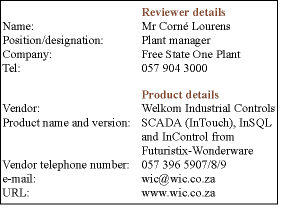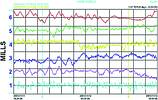

General
Q: What industry (eg mining, food and beverage, automotive, etc) is the scada being applied in?
A: Mining/metallurgical process.
Q: Describe the application briefly, giving a description of any existing control systems, any previous scada system that was in place etc. If relevant, describe the switchover from the previous system.
A: The Free Gold One Plant processes 390 000 tons of ore each month through its six mills. Efficient gold extraction relies on the quality of the milled product and operations personnel have to ensure that, in order to help optimise process efficiency, a constant quality of product (desired fineness of grind) is obtained at optimal throughput rates for each of the mills. Previously, the mills were controlled by six PLCs connected to five InTouch scada stations. However, the lack of consistent product quality combined with fluctuating throughputs triggered an investigation into a better process control approach. A rules-based control system became the solution of choice.
Q: Who did the system integration?
A: Welkom Industrial Controls.

Q: Approximately how many man-hours did the integration take?
A: 320 hours. Easy application installation, customisation and integration allowed us to focus on addressing the control logic problems rather than on the supporting technologies.
Q: How is the after-sales support handled (eg remote-dial-up, e-mail, Internet access, etc)?
A: Remote dial-up.
Q: What sort of licensing agreement is used on this particular system? Does one licence cover all modules, or can the user only buy those modules that he wishes to use?
A: Licensing for InTouch scada nodes, others bought as required.
System architecture
Q: How many tag points / I/O does the installation have? Analog? Digital? Maximum possible?
A: 3200 tags.

Q: What operating system is the scada running on (eg Windows NT, Unix etc)?
A: Windows NT.
Q: What impressed you most about the architecture? Open standards, wide range of drivers, the ability to upgrade, etc? Please elaborate.
A: Industry-standard, open solutions (InTouch, InControl, ActiveFactory) that are used in the majority of industrial control applications in SA. These products have proved themselves to be stable as well as easy to install, integrate and customise.
Q: Is the system integrated onto an intranet or the Internet? If so, does the configuration allow simple remote monitoring, or is it configured to allow full remote control? If not, what level of intranet/Internet control does the scada allow for future use?
A: The system is integrated onto an intranet for process monitoring and data analysis purposes.
Q: What sort of redundancy is built into the system?
A: We are currently busy implementing a redundant system architecture.
Graphics
Q: Describe the graphics development process - eg did you use standard library images, or did you have to draw images from scratch?
A: Both.

Q: How would you describe the library of graphic images?
A: Excellent.
Q: Did you use any 'special' images (eg embedded video clips, photographs, 3D images, etc)?
A: In the case of mechanical or control hardware defects, visual alarms are displayed and multimedia sound is used for audible notification.
Q: Did you run the scada in conjunction with any third-party application software? Describe.
A: Yes, the five existing InTouch scada HMIs are now used in conjunction with InControl, InSQL and ActiveFactory. InControl is used as a soft PLC that replaces the logic of the existing PLCs but still uses these controllers as I/O devices. This was necessary because of the complex rules-based algorithms that were to be used in the new system. InControl is integrated with the InSQL realtime database and ActiveFactory for automatic information collation and reporting.
Q: Does the scada allow for the user to create scripts to perform specific tasks? Describe any specific scripts that were written for this project.
A: Yes, scripts were developed for the automated printout of trends.
Management reporting
Q: Is a trending and historical data reporting system included? Please elaborate.
A: Yes, ActiveFactory. This allows operators, metallurgists and management to monitor the mass output of each mill as well their standard deviations in realtime either locally or remotely.
Q: Is a management reporting system included in the package?
A: No.
Q: Is the system integrated into a manufacturing execution system?
A: No.
Q: Is the scada system integrated into a management reporting or control system (eg SAP, Baan)?
A: No.
Q: Was any additional software development needed? Please elaborate.
A: No.
Conclusion
Q: What impressed you the most about the system?
A: Its low-cost, quick implementation and flexibility to cater for complex process changes and raw material variances. It was also unnecessary to purchase any additional control hardware and optimal use was made of existing resources (five InTouch HMIs and six PLCs).
Efficient gold extraction relies heavily on the quality of the milled product. We have to ensure that, in order to help optimise process efficiency, a constant quality of product (desired fineness of grind) is obtained at optimal throughput rates of more than 95 t/hr. Sometimes additional equipment such as particle size analysers are used on the final milled product as a tool to optimise the process, but at ±R320 000 capital cost per mill with a monthly maintenance cost of R30 000 per mill, this was not an option.
Our objective was to optimise the existing basic control loops on each mill by using the operator experience defined in the rules. The rules we have defined give us the flexibility to dynamically adapt and ensure optimal performance. We are striving to develop a system that automatically adjusts to process fluctuations but still allows operational personnel to interact and optimise according to conditions.
Q: What was the predominant feature (or features) that made you decide to employ this scada, rather than another (ie ease of use, support from the vendor, upgrade path, redundancy features, etc)?
1. Price/performance.
2. Flexibility.
3. Ease of integration.
4. World standard.
5. Ease of use.
6. Upgrade path.
7. Support from the vendor (Futuristix).
8. Open architecture.

© Technews Publishing (Pty) Ltd | All Rights Reserved